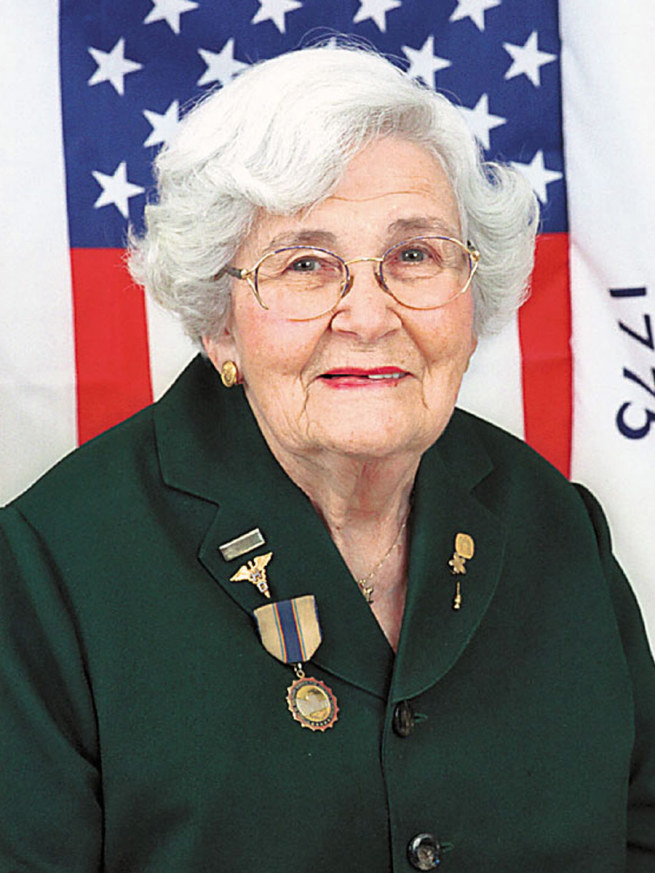World War defines a life
Nation and World
Experiences at World War II-era Madison College and with Tri-Sigma shaped Emily Lewis Lee's ('43) life
By Nancy Bondurant Jones
When Emily Lewis Lee ('43) returned to JMU in spring 2001 to participate in the university's celebration of James Madison's 250th birthday, the jacket she wore was adorned with five special pins. To her U.S. Army first lieutenant bars, a caduceus designating hospital dietician, her JMU pin and a Tri-Sigma violet, she added the insignia given to all former servicewomen who attended the dedication of the women's service memorial in Washington, D.C. The pins linked important facets of Emily Lee's past to the present.
Lee's experiences at World War II-era Madison College and with Tri-Sigma helped determined who she was and what she stood for. And although the war spanned only a brief four years in comparison to 51 years working with Tri-Sigma and the university's service boards, the war significantly shaped Lee's generation.
Some events carry such power that they forever define the lives of those involved. World War II was that event for Lee. Long after, Lee would preface her nostalgic conversations with "before the war" or "after the war." "Before" for Lee and other young women at the newly named Madison College was a halcyon time. When she arrived at school in 1939, the yearbook capsuled memories of "worship services in the green out-of-doors at camp … the shuddering organ in Wilson on Sunday afternoon worship … candlelight services … and firelight picnics in professor Dingledine's back yard."
From halcyon days to blackouts
But one Sunday their world turned upside down — the Japanese unexpectedly attacked the U.S. Naval Base at Pearl Harbor. President Franklin D. Roosevelt responded with a call to Congress for a declaration of war. At Madison College, patriotic fervor reigned. President Samuel Duke announced leave for all staff members who left for the military. Young women bought defense stamps, knit wool squares for overseas and collected tinfoil and tin cans for the "war effort." At least eight professors — Anderson, Barber, Mc-White, Pittman, Schneider, Schubert, Smith and Tressider — joined the armed services. Virginia Gov. Colgate W. Darden Jr. requested one-fifth of the college's typewriters for the army.
"At first it didn't change our lives too much," Lee said. "But then one of my best friends, Frances "Dinny" Agnor Traver, was engaged to a VMI cadet, so she left school to get married."
Soon, wedding announcements and news clippings lined Lee's scrapbook. By graduation in 1943, the halcyon days had disappeared — the college camp closed, Dingledine had died, and blackouts supplanted many candlelight evenings.
After graduation, Lee entered Johns Hopkins in Baltimore for a six-month internship followed by another six months at Halloran Hospital on Staten Island before she entered the Army Medical Corps as a dietician. Then came medical basic training at Atlantic City, where big hotels were serving as hospitals to ships unloading the wounded from Europe's battlefields.
Lighter moments eventually brightened the horizon. Like countless others, Lee met her future husband, Luther M. Lee, while they were both stationed at Ft. Bragg, N.C. "I outranked him when we were married in 1946," Lee said. "I was a first lieutenant; he was a second then."
End of war, beginning a new life
The war had ended, the Allies were victorious, and Lee was ready for her discharge. "We had to spend our first Christmas apart, though," she said. "He was at Fort Jackson, and I was at Fort Bragg. You know in the '40s, you just didn't travel like you do now."
Like millions of other returning service men and women, Luther decided to take advantage of the G.I. Bill, a thank you from a grateful nation to those who had answered the call to arms. He entered the University of South Carolina in Columbia to become an attorney. Going all year with only a week off at Christmas and one in the summer, he finished in 1950. The couple lived in one room, then in a small garage apartment.
"Living conditions were something at that time," Emily recalled. "I sat for days in that room with nothing to do while he was gone, so I went to the [Veterans Administration] hospital, and they said they'd love to have me. So I started working as a dietician."
At Madison College, then still officially termed "a state college for women," the times also were "a 'changing." Thirty-nine men enrolled full time in the fall of 1946. At the close of 1947, part- and full-time men numbered 101. It would take another decade, however, before Madison College housed males.
Honoring the contributions of a generation
Nearly six decades later, Emily Lee was widowed but still vitally involved with the university and equally proud of it and the wartime contributions of her generation. To reflect that continuing pride, she pledged the cost of a terrace for the new alumni building to remember and honor individuals connected with JMU who served their country in World War II.
Today, the alumni center displays the names of WWII veterans who attended, taught or worked in any capacity at Madison. And, their photos and written memories are included in a scrapbook housed at the Leelou Alumni Center.
